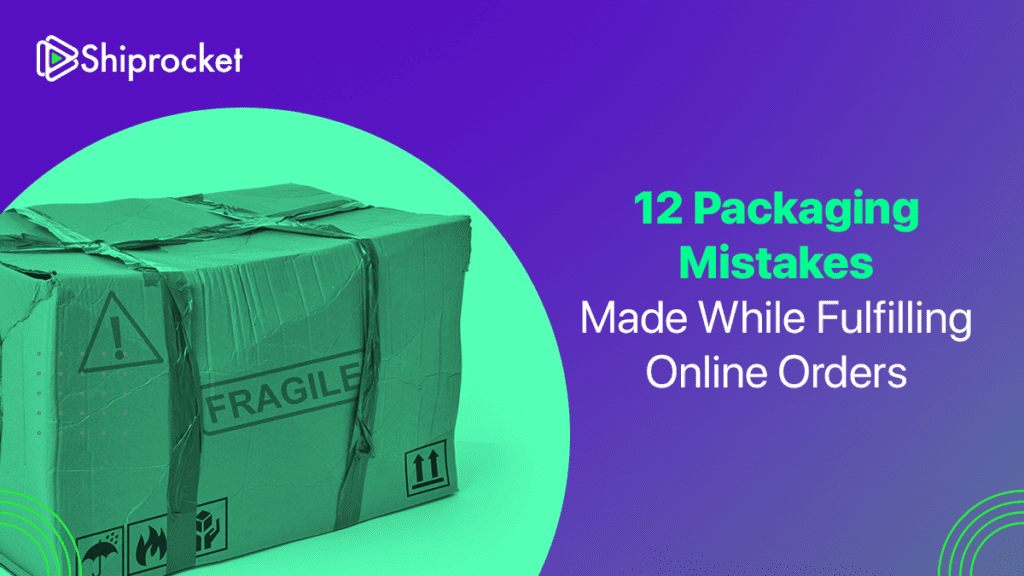eCommerce eCommerce 7 min read
12 Packaging Mistakes Made While Fulfilling Online Orders
🕒 July 17, 2022 by Reham Omar - 7 min read
- 12 Packaging Mistakes to Avoid:
- Packaging, More Or Less
- Inappropriate Packaging Pattern
- Using Low-Cost Packaging
- Shipping Expenses Not Calculated
- No Additives
- Inappropriate Box Size
- Packages That Are Difficult To Open
- Failure To Brand Your Package
- Ignoring Return Packaging
- Not Being Prepared For Package Changes
- Materials that are Not Recyclable
- Not Making A Shipping Supplies Inventory
- Conclusion
As an e-commerce merchant, you must understand the importance of packing in offering a superior consumer experience. However, many firms continue to underestimate the importance of proper packaging. Recognising that great packaging protects your product and acts as a customer’s initial impression of your company is critical. A consumer who receives defective merchandise or packaging mistakes feels helpless because he must go through the entire return process, which takes up a large amount of time.

12 Packaging Mistakes to Avoid:
Packaging, More Or Less
Did you know that almost half of the consumers would go to a different retailer if they get a broken product? Excessive or insufficient packing material is a major cause of damaged merchandise. For instance, suppose you’re delivering glass objects. There is a great risk of damaging the glass object if you use too much padding to cover the thing. If you do not offer to cushion, the things within will be harmed because of the friction created during travel. As a result, understanding the appropriate quantity of packaging for your items is critical. To guarantee that their goods arrive intact, eCommerce retailers must balance too much and too little packing. The idea is to use just enough padding to preserve your fragile goods while not splurging on materials.

Inappropriate Packaging Pattern
It may seem obvious, but the type of package you choose—bag, box, or envelope—and the size of what you’re shipping—are critical for various reasons. Avoid packaging e-commerce goods in mismatched packages to save money on shipping and limit the risk of theft and damage.
Using Low-Cost Packaging
Remember the first situation we presented? Cheap, ill-suited packaging leaves a bad impression on your clients, and you don’t want your brand to be linked with it. It now pays to spend some effort into utilising the proper packaging. As a general guideline, the packaging you employ should consider the weight of your products, their size, and their requirement for protection. This will not only safeguard your things throughout transportation, but it will also provide a great consumer experience when they arrive. This packaging mistake is made by most of the service providers in an eCommerce business.
Shipping Expenses Not Calculated
Shipping expenses are an unavoidable expense for online enterprises. If you don’t calculate them precisely, you risk incurring overhead expenditures you can’t afford. With this in mind, keep an eye out for hidden expenses like taxes, residential & weekend delivery costs, and fees for recipient signatures. Remove the things you don’t require and ensure you’ve got how much you’ll have to pay for the ones you do.

No Additives
When there is room in a shipping box, the shipped object might shift and move around—unless fillers are used to fill the vacant area. Plastic (bubble wrap, airbags), paper and cardboard, and styrofoam are all fillers. The idea is to fill as much space as possible with the least amount of weight and trouble (on the recipient’s end). Avoiding product damage in eCommerce packing necessitates effective “infill” in your shipping containers.
Inappropriate Box Size
Two conventional box sizes will not suffice for firms that sell a range of items. A little item will usually be shipped in the wrong size box, with too much bubble wrap or additional cushion. If this happens, your consumer will certainly evaluate you, questioning why you squandered so much box space for such a small item. Furthermore, the possibility of the little object experiencing excessive movement inside the package is significant, increasing the danger of fracture.
We don’t advocate stocking a variety of box sizes in your fulfillment facility. However, shipping boxes must be planned around the items to ensure damage-free product delivery.
Packages That Are Difficult To Open
Packing tape is only one method for sealing an eCommerce shipment package. While tape is not always the greatest package sealer, glued-closed boxes are much more difficult to open, which may be stressful for purchasers and cause them to harm their items inadvertently. This packaging mistake is very stressful and gives irritation to the customer.
Consider delivering things such as clothing in flyers or courier bags since they are easier to open. We realize how difficult it is to find out how to ship safely. Still, a typical packing error is for firms to make their products so difficult to open that the client on the other end is disappointed by the unwrapping process.
Failure To Brand Your Package
What good is a cake without icing? Branding packaging is an important strategy to expand reach, but a typical order packaging blunder is skipping the customization of the delivery package. A simple personalized label or branded packing tape might help tell your company’s narrative. Consider how your packaging may help you sell more things. Additional fees are associated with custom-branding your shipping products, but as brand familiarity grows, so will sales. Small details, such as providing a thank you letter with a voucher, are clever ways to keep customers coming back for more.
Ignoring Return Packaging
Returns are an unavoidable feature of the internet selling process. Avoid the error of packing your items in ways that make it difficult to return them. Shipping envelopes, for example, must be cut open and cannot be reused, resulting in waste and unnecessary extra procedures for you and your clients. Instead, try perforated mailing bags or envelopes with an extra sealable “flap,” enabling returned products to be sent back in the same envelope fast. If you can create a flawless customer experience, you will win client loyalty and future revenues, more than compensating for your losses.
Not Being Prepared For Package Changes
Carriers frequently change package costs and shipping policies. If you are not prepared to adapt to these developments, you risk price overruns and other budgetary concerns. To avoid this issue, get in touch with shipping companies regularly and be informed of any changes they intend to make.
Materials that are Not Recyclable
Many shipping and packing materials, such as plastic and styrofoam, are environmentally harmful. Given the increasing consumer knowledge and interest in these problems, using recyclable and reusable packaging wherever feasible is critical. Avoid upsetting eCommerce shoppers and creating unnecessary waste by choosing “greener” solutions such as packing material produced from organic, biodegradable substances and cardboard shipping boxes that cannot be reused or recycled.
Not Making A Shipping Supplies Inventory
Why not keep track of your shipping materials the same way you keep track of your inventory?When you run out of shipping materials, it isn’t easy to send your items out on time, which can significantly influence your business’s health. With this in mind, create a system for tracking your shipping supplies and setting up order packaging triggers to protect you from running out of anything.
Conclusion
Now that you’ve learned about the most common packaging mistakes made by eCommerce companies, it’s up to you to learn from them. Avoid this eCommerce packing mistake to help your company’s earnings increase cost-effectively, customer-friendly, and long-term.
Shipping and fulfillment are two of the most critical services an online business provides. Unfortunately, many internet retailers do these two things incorrectly, harming the customer/company connection. This is truer now than ever in the era of subscription box services and increasing fulfillment.




